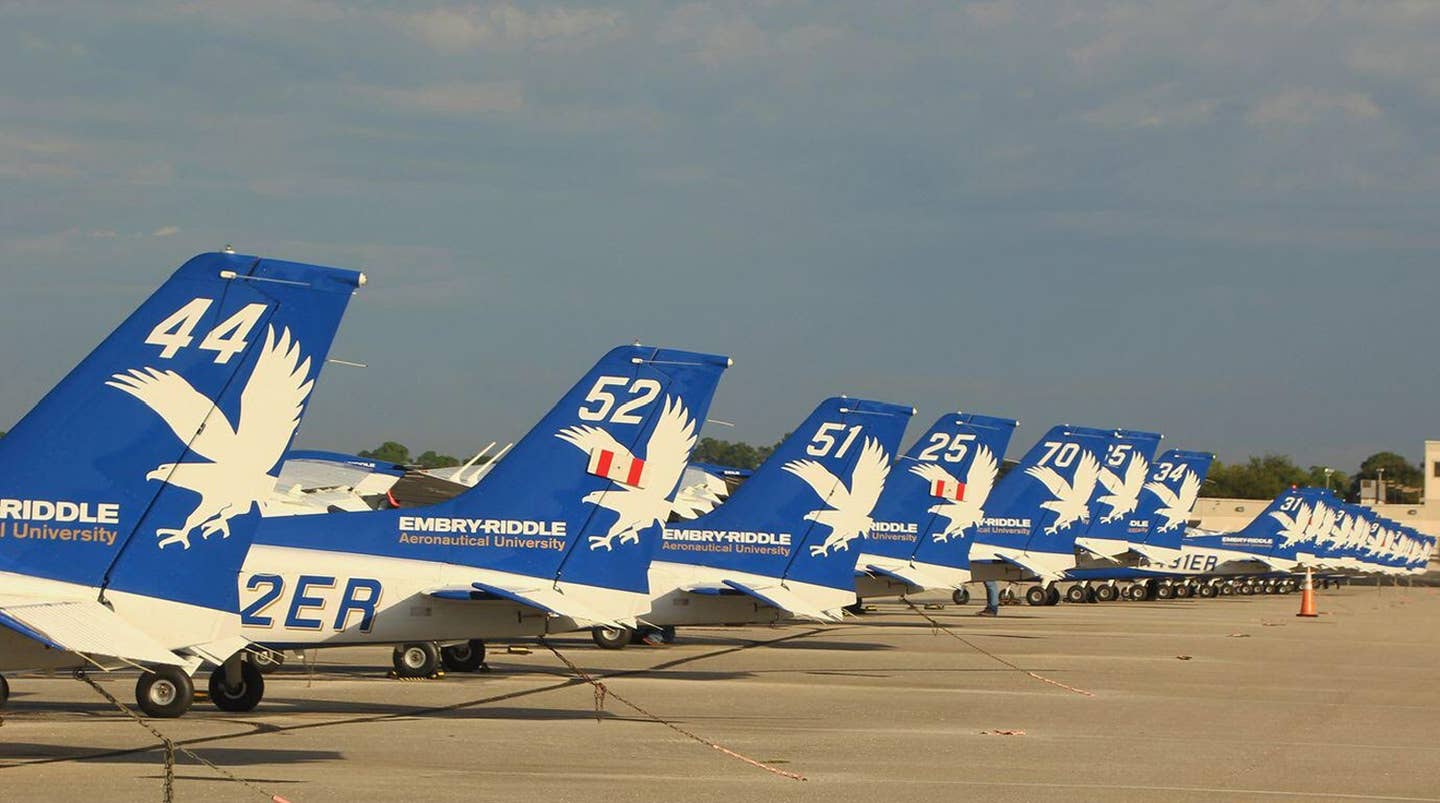
ERAU immediately grounded the rest of its Piper Arrow fleet following the April 2018 accident. Gary Rossier
There’s a reason pilots don’t train for some inflight failures. Sometimes those failures are so rare that the likelihood of a pilot encountering them is not deemed worthy of more than a mention during ground school. Then there are those failures for which no solution exists, as was experienced by a designated pilot examiner and a commercial student in April 2018 near Daytona Beach International Airport when the left wing of the Piper Arrow they were flying separated from the airplane. Following a touch-and-go landing, the Piper was climbing on a westerly heading at about 80 knots when, with less than 1,000 feet of altitude between the airplane and the ground, the structural failure occurred. The DPE and the student were both killed in the accident.
Early in the first page of the final accident report released by the NTSB last week – ERA18FA120 – the cause of the accident became clear. “Metallurgical examination of the accident airplane's left-wing main spar lower cap found that it exhibited fracture features consistent with fatigue through more than 90% of the cross-section, reducing its residual strength capabilities almost completely.” In all, three major fatigue cracks were eventually found in the broken wing. The report added that, “A small fatigue crack was also identified in the accident airplane's right-wing main spar lower cap; however, that crack had not progressed to the point of failure.”
The 10-year old aircraft was used only for flight training at Embry-Riddle Aeronautical University and had accumulated approximately 7,600 hours of flight time. “A review of the operator's airframe discrepancy log for the life of the airplane and flight crew safety reporting system for the 24 months preceding the accident found some reported flap extension overspeed, gear extension overspeed, and hard landing events. In each case, the events resulted in airframe examinations during which no defects were noted by maintenance personnel. Interviews with flight instructors did not yield any safety of flight issues or critical airframe or loading exceedances caused by pilot operation that would be expected to precipitate cracking.”
Piper published a service bulletin in 1987 for a wing spar inspection on the PA-28 series that would not have taken effect on this airplane until it had accumulated almost another 23,000 flight hours. The NTSB said, “Maneuver loads experienced by the accident airplane were likely similar to the maneuver loads for basic instruction published in AC 23-13A, which are slightly higher than for personal use.”
The Board also said, “Gust loads in the accident airplane flight training environment could also be higher than in the personal use environment (in the personal use environment airplanes are typically operated at higher altitudes, and gust loads are generally more severe and frequent at lower altitudes for any given airspeed). However, the gust loads for basic instruction are presented as identical to personal use in AC 23-13A. Loads associated with taxi movements for the accident airplane were likely similar to those of other operations other than agricultural application as shown in AC 23-13A.”
The Board believed however that “landing impact loads for the accident airplane were likely higher and more frequent than other types of operations. Sink rates for basic instruction use as published in AC 23-13A are higher than that of other uses including the pipeline survey use and normal use analyzed for SB 886, and higher sink rates correspond to higher landing impact loads.”
Following the accident, the Board examined 16 airplanes from 4 flight schools (including ERAU) using eddy-current inspection of the outboard attachment holes where the cracks appeared in the accident airplane. Times in service ranged from 2,777.5 to 10,301.5 hours, and estimated landing cycles ranged from 8,841 to 39,000 cycles.
“Among the inspected airplanes, a crack was found in one wing of ERAU airplane N104ER, which had a time in service of 7,660.7 hours and 33,288 landing cycles. No additional cracks were detected in the remaining airplanes, including four airplanes with higher estimated landing cycles. However, due to the limited sample size and the expected variability in fatigue crack initiation times, the absence of detected cracks in airplanes with more cycles and/or hours than N106ER and 104ER does not eliminate the risk of fatigue cracking due to loads associated with a more severe training environment.”
“The NTSB concludes that, due to flight training maneuvers, significant operation at low altitudes, and frequent landing cycles, the accident airplane (and its sister airplane in the operator's fleet) likely experienced landing, gust, and maneuver loads that were more severe than expected for training aircraft when SB 886 was developed. Therefore, the low-altitude flight training and frequent landing environment likely resulted in the accident airplane accumulating damaging stress cycles at a faster rate than a personal use airplane.”
An important finding by the NTSB was that neither pilots, instructors or maintenance personnel would have likely been able to visually detect any of the cracks from inside or outside of the airplane. “Evidence of the presence of a crack would only have been visible after cracking had begun in the doubler and grown past the bolt head to a significant length. The only reliable method to detect the fatigue cracking in the wing main spar, as installed, would have been a nondestructive inspection procedure, such as a high frequency eddy current bolt hole inspection.”
The NTSB said the FAA issued a notice of proposed rulemaking eight months after the accident proposing such an inspection for all Piper PA-28 series airplanes, except the PA-28- 201T and PA-28-236 model airplanes; all Piper PA-28R model airplanes; and all Piper PA-32- 260 and PA-32-300 model airplanes.
In the NTSB's February 15, 2019, comments to the FAA, “we expressed our support of the proposed AD's inspection requirements but urged the FAA to reexamine the proposed AD's applicability to certain airplanes based on airplane usage. As of the date of this report, the FAA has not published an AD for inspection of the accident airplane type and other similar types, especially those operated in the flight training environment.”
The NTSB found the probable cause of this accident to be “extensive fatigue cracking in the left-wing main spar lower cap and doublers, which resulted in the in-flight separation of the left wing. The fatigue cracks initiated and grew to a critical size due to flight and ground loads associated with flight-training involving flight-training maneuvers, significant operation at low altitudes and frequent landing cycles. Previously established inspection criteria were insufficient to detect the fatigue crack before it grew to a critical size.” In other words, the accident was deemed unsurvivable.

Sign-up for newsletters & special offers!
Get the latest FLYING stories & special offers delivered directly to your inbox






